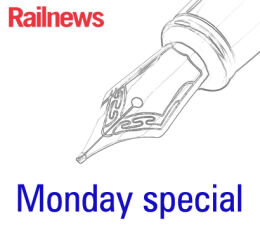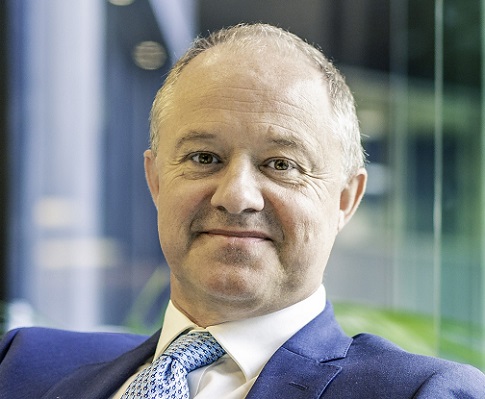Posted 20th October 2025
Wasting money on a gold-plated railway


Phil Marsh
4 comments
Andrew Haines joined the railway in 1984, at a time when British Rail was reshaping itself – not in the sense of the Beeching closures, but changing its structure radically for the first time since the 1948 nationalisation by preparing to abolish the Regions and replacing them with ‘businesses’.
This programme, which became known as ‘Organising for Quality’, took the rest of the decade to complete, and at the end of it the passenger railway was now run by InterCity, Network SouthEast and Regional Railways.
Although BR was improving, it was very far from perfect. Andrew recalls: ‘The railway has changed immeasurably in many ways since I joined in 1984.’
He remembers some of the key elements of the industry, such as the safety record, accessible (or inaccessible) travel and the state of the major stations, many of which needed upgrading.
‘There was a fatal accident every year’
There was a fatal accident every year, more than 20 track workers were killed annually, wheelchair passengers were typically forced to travel in often filthy guards’ vans, and there were no ramps at many stations. Around 20 passengers a year died falling from slam door trains, which lacked secondary locking.
Passengers were forced away from the railways by very significant fare increases which were not the fault of BR, but because the government of the time was obsessed with railway costs.
In the early 1990s Nigel Lawson recession, Network SouthEast was on the verge of breaking even. This was partly as a result of political instructions to raise fares as much as possible.
The railway we have now, for all its faults, has been utterly transformed, according to Haines.
It is the world’s safest railway, while major, and many other stations, have been transformed along with rolling stock in the last 40 years. We carry about 2.5 times the number of passengers than British Rail.
Now we will soon have Great British Railways. Why is Haines in favour of this reform?
‘Because the biggest need is for a single guiding mind. If you have scarce capacity and more demand for trains, there needs to be investment and confidence that there will be a return for that investment whether you are a government or a private investor. This can only be delivered if there is a single body optimizing capacity of the system.
‘simplification and integration’
‘And that for me is absolutely at the heart of the biggest single reason I’ve spent the last seven years making the case for simplification and integration. At the heart of GBR, if you believe in a growing railway, and that successive Governments are going to invest in a railway network because of the broader social and economic benefits, then you need an entity that will bring those benefits.
‘In the 1980s, BR lived with impossible means. Quality of service and safety suffered but it absolutely lived within government constraints.
‘The Government set different priorities with privatisation and the early franchises were successful.
‘Now we need to reflect on priorities for the next decade.
‘The Bill is due at the House of Commons soon, and be through by Christmas. It may then have to wait for the second Parliamentary session to commence before going to the House of Lords.’
Haines thinks late summer 2027 is the earliest realistic time for GBR to go live. In the meantime, more operators will have been renationalised, with Chiltern Railways and GWR likely to follow Govia Thameslink Railway, which leaves the private sector on 31 May next year.
‘We have to start delivering’
Haines believes that the electorate see renationalisation as a simplification and consolidation as a proxy for that. The public do not like the confusion and the lack of accountability – and want public ownership.
But he warns: ‘We have to start delivering, and that’s why Lord Hendy has been a strong advocate for setting up Business Units sooner than later and the transfer of staff into DFTO is seen as the start of this. They will be separate companies but have an integrated profit and loss account, which makes a lot more sense of how you run the system on a whole business basis.
Andrew’s successor Jeremy Westlake, who started work today, has been working for 18 months on these accounts and is consolidating them into a single set for the first time since 1994.
He points out: ‘We have been actively dissuaded from creating this information because of the need to protect the separation of accounts between competing train operators so information was not being shared. A lot of people in the structure did not want to share information. The GBR bill removed much of this reticence.’
And what about those privatisation years? Have they left the railway better off?
Andrew says: ‘Why does Network Rail “gold plate” assets? Because that’s what we are told to do, more or less. It is an inconvenient truth that a lot of other people have no reason not to do it.
‘The system drives people to say “no” ’
‘Signal post telephones were installed on the Levenmouth line. Why? Because the RSSB Committee wouldn’t allow us to replace these despite GSMR cab communications, which we have had for 20 years or so. Cab Secure Radio is 30 years old. How many times would those telephones be used? I suggest they would never be used but they were insisted on by a committee of a majority of train operators.
‘Two and a half years ago one of our electrification engineers went to one of the RSSB committees and suggested raising bridge parapets immediately above the OLE rather than extending them the whole width of a bridge. If we did that, we would save £750 million across the network. This was rejected on sight because there was no upside for them. The system drives people to say “no” as there is no benefit to them, but there may be risk. They are not bad people but there is no system to measure the whole benefit.’
(This is an abridged version of a longer interview which will be published in the November print edition of Railnews.)
Readers’ comments
I have often wondered why the whole of the bridges had raised parapets when the Chase Line was electrified and now I know why. Does seem an additional waste of money protecting embankment areas where there is no OHL or gantry infrastructure adjacent to bridge. Each location should be assessed instead of a blanket ‘we must do this in every case’.
Dave Cresswell, Walsall
Interesting to read Sir Andrew’s view. I joined the railway in 1977 so have seen the changes he talks of and a few more! I hope GBR will simply matters which in many areas are unnecessarily complex, but what I foresee is further and different complications where we have open access and freight operators running on the GBR network and different operational structures in Scotland and Wales and also in various regions such as Merseyside and Greater Manchester. I for one always aim to seek simplified and less costly solutions in my work when possible! Whilst I would broadly agree with his view of the redundancy of SPT's on the Levenmouth line I had, as a passenger on an otherwise deserted station several years ago, the need to use an SPT to alert signalling staff of a safety issue on a passing freight train. I'd not have been able to do that had it not been there! Yes, there are many more 'Help Points' on stations now, but they wouldn't contact the signalling staff direct and a delay could have lead to a derailment.
Tim Casterton, Leighton Buzzard
After 30 years plus of the privatised railway no satisfactory answer has been given as to why costs were allowed to escalate in the way they have. Compared to the strict budgetary discipline that BR was expected to operate under the railway has seen a loosening of the purse strings beyond BR's wildest dreams through the availability of debt financing and leasing arrangements in addition to direct government support. However while the additional funding sources have been welcome the ultimate guarantor has still been the Treasury. What does remain in dispute is the deployment of this largesse and if it has been value for money compared with the outcomes achieved under BR pre-privatisation. One would have expected the industry regulator the ORR would have had its finger on the pulse to provide the answer. However the impression is left that due to the post-privatisation structural upheaval an answer to this question has proved too difficult if indeed the regulator sought to make the comparison. A conclusion has to be drawn that in its role of economic regulation that ORR has been a failure. Subject to the publication of the Railways Bill establishing GBR it is clear the ORR's role in its current form is limited. As a stated government objective is to reduce the regulatory burden a reformed ORR achieves that aim. With South Eastern Railway in the vanguard initial public statements appear promising that as wheel and rail are reintegrated aligned objectives and a common budget can start bearing down on the previous transactional cost and duplication. As more TOCs are brought back in-house the objective should be to see those savings multiply.
Chris Jones-Bridger, Buckley, Flintshire
The declared aim is that, in return for a grand, monolithic timetable with whole sets of interdependent movements (vertical integration), there will be a high degree of punctuality and robustness in the timings of individual trains. Well, yes this is probably a logical result, but there would seem to be another scenario in which the whole timetable can gain an optimum combination of flexibility with efficient use of resources. If this is correct, where IT is becoming able to cope with such systems, then the necessity for vertical integration may not be so important.
